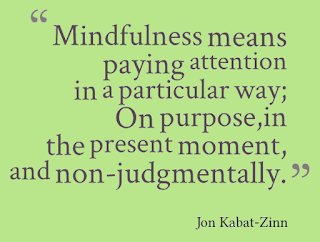Monday/ Tuesday November 25/ 27 Mindfulness Days practice
Learning Target: 11-12R6: Analyze how authors employ point of view, perspective, and purpose, to shape explicit and implicit messages
Please turn in your completed The Love Song of J. Alfred Prufrock graphic organizer.
In class over the next two days: mindfulness in education in the classroom. This will involve some physical practice, art, writing reflections and sharing out.
Everyone present, who participates whole-heartedly, will recieve 100 points in the quiz section for EACH day. There is no make up for this. If you are not present, you are excused.
1. Mindful practices work to help students return from distraction and dysregualtion to a sustained point of focus. Mindful practice helps you track your emotions and find balance. This also helps strengthen the parts of the brain that correlate with emotional regualtion.
2. What this means that is that mindfulness allows a student to become self-aware of an emotion, rather than being caught up in the feeling.
3.Mindfulness practice allows a student to sustain focus, even with distractions.
4. Mindfulness builds empathy
5. Mindfulness reduces stress
6. Mindfulness builds self-compassion, kindness and self-esteem.
7. Mindfulness promotes open-mindfulness
8. Minfulness promotes contentment.
9. Mindfulness promotes congnitive flexibility, helping a student make constructive and conscious choices.
10. Mindfulness builds resilence. Students are able to cope better with difficult emotions admidst adversity.
__________________________________________________
Number 1: Mindfulness Reflection Chart.
Number 2: "Our bodies are our gardens to which our wills are gardeners." William Shakespeare, Othello
Learning the language of sensations is foundational for mindfulness; this allows us to learn the language of the mind and heart as well. We are going to look at our own physical experience, imagining our bodies as a "foreign country we are visiting for the first time; we must learn the language and the landscape.
1.Move the desk aside.
2. Sit comfortably in your chair
3. Raise one hand and take a good look at it.
4. Notice the lines, colors and shape of your hand, as if you have never seen it before.
5. Keep your hand up; now close your eyes.
6. Think to yourself how you know the hand it there, even if you cannot see it.
7. Is your hand hot, cold, itchy, heavy, light, soft, damp, dry. Note these feelings.
8. Wiggle your fingers. Note the sensations.
9. Blow lightly on you hands.
10. Scratch one finger to another.
11. Rub your hand on your leg.
Journal 1: Mindfulness Preparation (handout).
"We don't stop playing because we grow old; we grow old because we stop playing."
Number 3: Using external movements to focus deeply on the feelings inside, noticing subtle movements and stillness. How does our breath move through the body?
1. Stand up and move desk / chair, so that you have room for large movements.
2. Spiderman breathing:
Breathe in with your hands close to your body; then whilst breathing out, let your arms shoot out as if you were creating a web.
3. Dolphin breathing:
With each breath, curve your arms in front of you, like a dolphin jumping out of the water. With each exhale, bring your arms down.
4. Butterfly breathing: let your wings (arms) open to the sides on the inhale and close together on the exhale.
5. Can you stand totally still without moving a muscle for one minute? Silent; what movements do you notice when everything is immobile. Note your breathing.
Discussion question: How does your body feel after participating in this exercise?
Journaling page 2: Drawing calm / chaos
page 3: animal breathing / writing
Conclusion: "Don't believe everything you think."
On the last page is a popcorn box. Please follow the instructions.
Make sure your name is on the front page; so that you receive credit.
Day 2 continuation
"Your mind is like this water, my friend: when it is agitated it becomes difficult to see. But if you allow it to settle, the answer becomes clear."
What types of storms have you had to buffer in life?
Name_____________________________--Below is a picture of an
anchor that is settled in stillness beneath the rough waves of the ocean. Write
4 ways your mind gets distracted and how you can bring it back to a place of
calmness.
___________________________________________________________________----
FOCUS EXERCISE
1. Look at the spot for 30 seconds
2. Look at the spot again, and I am going to distract you.
3. Now gaze the spot and let your eyes wander.
When I say go, pick up your pencil and without looking anywhere but your paper, list everything you saw in the room.
*******************************************************************************
Dialogue: What id you notice about attention and distraction when you tried to focus?
Where else in your life could you practice seeing things with new eyes?





Comments
Post a Comment